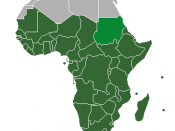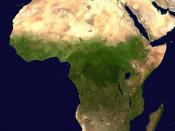Until recently, there were some areas of the world that had remained fairly unaffected by AIDS. Today, there is not a single country in the world which has totally escaped the AIDS epidemic. As the epidemic has grown, a few of the developed nations which were affected most in the 80's such as the United States have reported a slowing in the rate of new infections and a stabilization among existing cases with lower mortality rates. However, despite ever-changing global AIDS pandemic, one issue has remained unchanged; no region of the world bears a higher AIDS-related burden than sub-Saharan Africa. I will examine the demographic effects of AIDS in Africa, focusing on the most affected countries of sub-Saharan Africa and consider the present and future impact of the AIDS epidemic on major issues such as fertility, mortality, life expectancy, gender, age, and family structure.
Although the sub-Saharan region accounts for just 10% of the world's population, 22.5
million of the 33.4 million people living with HIV/AIDS in 1998 lived within one of the 34 countries of sub-Saharan Africa, and of all AIDS deaths since the epidemic started, 83% have occurred in sub-Saharan Africa (Baylies 62). Among children under age 15 living with HIV/AIDS, 90% live in sub-Saharan Africa as do 95% of all AIDS orphans. Within the sub-Saharan nations, 1 out of every 4 adults is HIV-positive (Baylies 64). Taxing low-income countries with health care systems insufficient in handling the weight of non-AIDS related illnesses, AIDS has ruined many of the sub-Saharan African economies. The impact of AIDS on the region is now changing mortality and fertility rates, reducing lifespan, which ultimately affects population growth.
Even thought Africa is the region of the world that is most affected by AIDS, and although no country has entirely escaped its effects,


